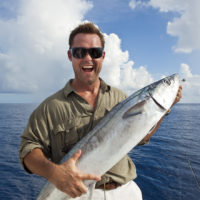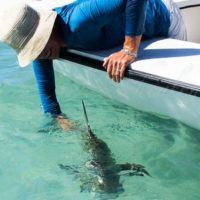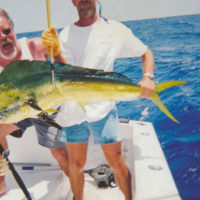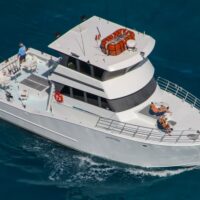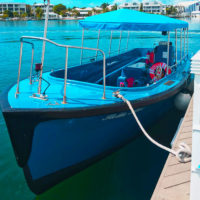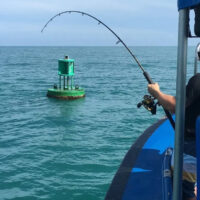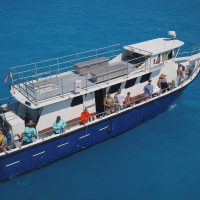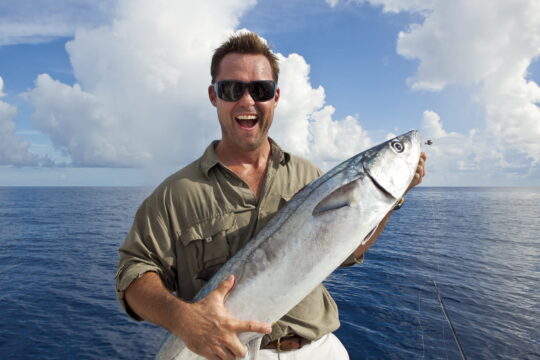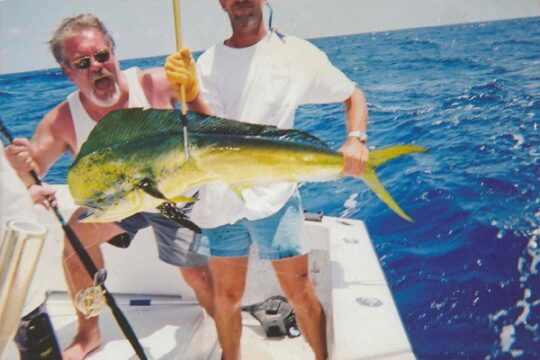Fishing for Blue Marlin in Key West
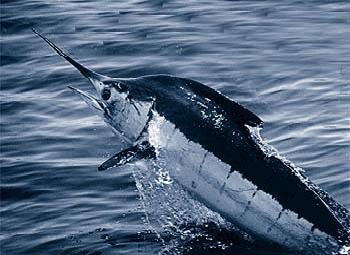
The legendary Blue Marlin is one of the world’s greatest game fishes. It is also among the largest fish species, with some females running well over 1,000 pounds. Every year, tournament pros and hopeful amateurs alike come fishing in Key West to chase this ultimate blue water trophy fish. (Florida Record: 1046lbs)
Blue Marlin (Makaira nigricans)
The Blue Marlin is a large pelagic billfish that is named for the cobalt blue to blue-black color of its back. Like other billfish, the Blue Marlin has pigment-containing iridophores and light-reflecting skin cells that let it rapidly change color, but it is most commonly seen with silvery-white sides and belly. About 15 rows of pale, cobalt-colored stripes that break up into round dots and thin bars run along both sides of the Blue Marlin.
The Blue Marlin’s most distinguishing features are its long, stout bill and broad, deeply forked tail. In fact, Makaira, the genus name for Blue Marlin, refers to the fish’s bill and is derived from the Greek and Latin words for sword or dagger. The Marlin’s bill, measured from eye to tip, constitutes about 20% of the total body length. The Blue Marlin has two dorsal fins and two anal fins, with the first dorsal fin being somewhat similar to a Sailfish dorsal fin but much smaller.
An interesting feature of the Blue Marlin is the ability of the long, narrow pectoral fins, the caudal fins, and the anal fins to fold down into grooves in the body to streamline the fish and reduce drag. This allows the Marlin to reach top speeds of around 50mph. Another unusual characteristic of the Blue Marlin is the great size of the females in comparison to the males. Females can reach 14 feet in length and weigh more than 1,400 pounds while males rarely exceed 350 pounds. Average sizes tend to be in the range of 6-8 feet and 200 to 400 pounds.
Blue Marlin Habitat and Behavior
Blue Marlin are a pantropical species found throughout the tropical and subtropical zones of the Atlantic, Pacific, and Indian oceans. It is a highly migratory blue-water fish that spends most of its life in the open sea far from land and typically travels thousands of miles in its seasonal range. Blue Marlin can be found year-round in tropical Atlantic Ocean waters of the Northern and Southern Hemispheres, with a range that contracts towards the Equator during colder months.
Warm currents such as the Gulf Stream in the western Atlantic have a major influence on the Marlin’s migration patterns. In the Keys, Marlin can be found in mid-summer, but they are most numerous in the fall from October through early November when the Gulf Stream moves inshore. In the northern Gulf of Mexico, it has been observed that water color seems to affect the Blue Marlin’s distribution as it shows a preference for blue water.
Their migratory behavior makes it difficult to investigate the reproductive cycle of the Blue Marlin. They are known to reach sexual maturity at about 3–4 years of age for females and 2 years for males. Spawning occurs offshore, and the eggs and larvae float with the current until the larval fish find shelter among floating seaweed patches.
The Blue Marlin feeds during the daytime on a wide variety of organisms near the surface. Mackerel, tuna, and squid are important prey items, and Marlin that are feeding near oceanic islands and coral reefs will take the juveniles of inshore fish species. Blue Marlin can feed on small but numerous prey such as filefish and snipefish, but are also known to take prey as large as White Marlin as well as Yellowfin and Bigeye Tuna in the 100-pound range.
When feeding, a Blue Marlin makes high-speed slashing attacks through a school of fish or other prey, using its bill to stun, injure, or kill fish then turning back to eat the wounded prey. A 2007 Japanese study of stomach contents from Blue Marlin caught by commercial trolling vessels found that almost half of the undigested prey items taken from 227 Blue Marlin had signs of spearing, slashing, and other injuries that appeared to have been caused by the Marlin’s bill.
Fishing for Blue Marlin
Blue Marlin have been prized as sportfish since at least the 1920s and early 1930s when pioneering big-game fishermen encountered them offshore of Bimini and Cat Cay in the Bahamas. During that period, American authors and journalists Zane Grey and Ernest Hemingway put Caribbean sportfishing on the map by writing extensively about their exciting adventures fishing for Blue Marlin off the Florida Keys, the Bahamas, and Cuba. The Key West Marlin Tournament has been drawing competitive Marlin anglers to the island since 1982.
In Key West waters, Blue Marlin are usually targeted southeast of Key West at a deep-water bank known as Wood’s Wall. The heaviest saltwater rigs are used, and trolling orange and black lures or sending back big blue runners and other large fish as live bait are two common Marlin fishing strategies. It is also typical to catch Marlin while fishing for Mahi-Mahi or Dolphinfish. The Marlin will show up and eat smaller Mahi as they are being reeled in. A heavy rod set up with a 250lb wind-on leader and a short 250-lb wire leader is kept ready, and when a feeding Marlin is sighted, a small Dolphin is rigged as live bait and sight-cast to the hunting Marlin.
Whatever fishing technique is used on the Blue Marlin, a hookup results in a fight that can last for 6 hours or more and leave even the toughest sportfisherman exhausted.

